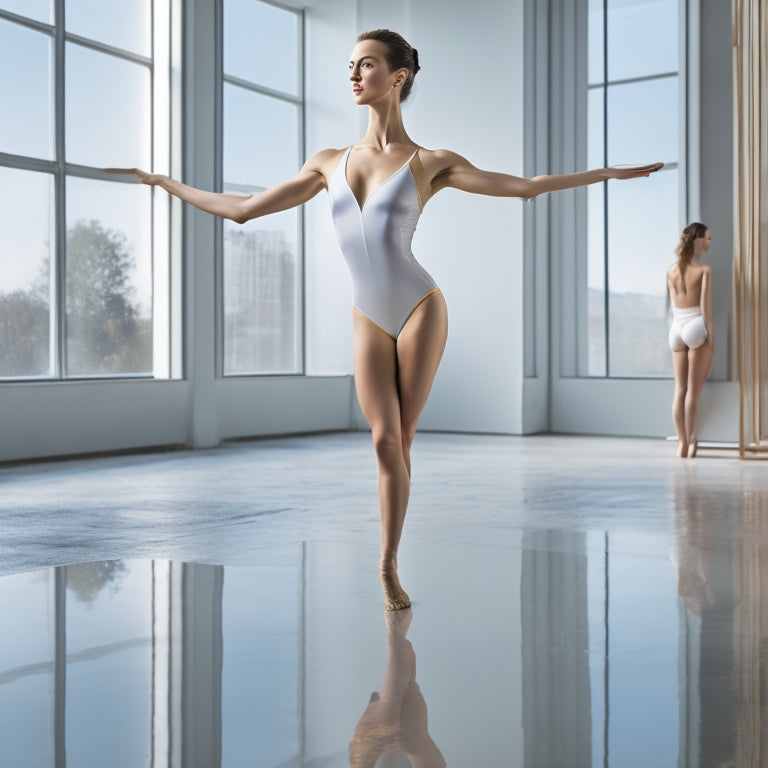
Does Ballet Change Your Body Shape?
Share
As you commit to a regular ballet practice, you can expect to see transformative changes in your body shape, from toned muscles and improved flexibility to enhanced posture and alignment, as ballet's unique combination of strengthening, stretching, and alignment exercises reshapes your physique. Your core strength and stability will improve, and you'll notice a decrease in body fat percentage. Meanwhile, your posture will become stronger and more confident, reducing back pain and boosting your overall confidence. As you explore the intricacies of ballet, you'll uncover the full scope of its impact on your body shape and discover even more surprising benefits that will take your transformation to the next level.
Key Takeaways
• Ballet develops and tones multiple muscle groups, particularly in the core, legs, and glutes, leading to a more sculpted body shape.
• Regular ballet practice increases flexibility and range of motion, resulting in a more fluid and efficient movement pattern.
• Ballet improves posture and alignment, which can lead to a more confident and graceful appearance, and reduced back pain.
• While ballet can aid in weight loss and fat reduction, it's essential to combine it with proper nutrition and rest for optimal results.
• Genetic factors influence an individual's body shape and ballet performance, but consistent practice and proper training can help overcome genetic limitations.
Ballet's Impact on Body Composition
As you commit to a regular ballet practice, your body composition begins to undergo a remarkable transformation, with increased muscle tone and a leaner physique emerging over time. This shift is largely attributed to ballet's impact on hormone regulation, which helps balance your body's natural rhythms, leading to a more efficient metabolism and fat loss.
Additionally, ballet's focus on weight-bearing exercises helps improve bone density, reducing the risk of osteoporosis and fractures. As you continue to practice, you'll notice your body becoming more toned and lean, with a greater sense of freedom and flexibility.
With regular ballet practice, you can expect a more balanced and healthy body composition, empowering you to take control of your overall well-being.
Muscle Development and Toning
Your ballet practice targets multiple muscle groups simultaneously, engaging your core, legs, and glutes to develop long, lean muscles that are both strong and flexible.
As you execute intricate movements, you're building toned muscles that will enhance your overall physique. This holistic approach to muscle development helps prevent injuries by strengthening your core, which provides stability and support.
Moreover, ballet helps identify and correct muscle imbalances, promoting a more harmonious distribution of strength throughout your body.
Flexibility and Range of Motion
Through deliberate, controlled movements, ballet helps increase your flexibility and range of motion by targeting specific joints and muscle groups, allowing for a more fluid and efficient movement pattern.
As you practice ballet, you'll notice improvements in your spinal extensions, allowing you to stand taller and move with greater ease.
Joint mobilization exercises, like leg swings and arm circles, will also increase your range of motion, giving you the freedom to move effortlessly.
With consistent practice, you'll experience increased flexibility in your hips, knees, and ankles, enabling you to move with greater precision and control.
This newfound flexibility won't only enhance your ballet technique but also translate to everyday activities, giving you the freedom to move with confidence and grace.
Posture and Alignment Improvement
Proper alignment, fostered by ballet's emphasis on precise body positioning, lets you stand taller and move with poise, as a strong, statuesque silhouette emerges from the harmonious alignment of your head, shoulders, and hips. This newfound posture brings confidence and freedom to your movements, allowing you to take up more space and own your presence.
| Benefits | Description |
|---|---|
| Improved Spinal Awareness | Develops a stronger, more flexible spine |
| Enhanced Pelvic Positioning | Stabilizes and aligns your core |
| Increased Confidence | Own your presence with poise and grace |
| Better Balance | Move with ease and stability |
| Reduced Back Pain | Strengthen your back and alleviate discomfort |
Weight Loss and Body Fat
Focusing on cultivating good posture and alignment through ballet, you'll also start to notice a significant impact on your weight loss journey and body composition.
As your body adapts to the demands of ballet, you'll experience an increase in your resting metabolic rate, which helps you burn more calories at rest. This can lead to weight loss and a decrease in body fat percentage.
However, taking into account fatigue factors, such as overtraining, is crucial as it can lead to a metabolic slowdown. By balancing your ballet practice with proper nutrition and rest, you can optimize your weight loss progress and achieve a leaner, more toned physique.
With consistent practice and patience, you'll be on your way to a stronger, healthier, and more radiant you.
Building Core Strength and Stability
By engaging your core muscles in ballet exercises, you'll develop the strength and stability essential for executing intricate movements and maintaining good posture.
As you work on building your core, you'll find that your overall balance and coordination improve greatly. This is because your core muscles, including your pelvic floor, are the foundation of your body's stability.
To maximize the benefits, focus on proper breathing techniques, engaging your diaphragm to support your movements. As you strengthen your core, you'll notice improved control and precision in your movements, allowing you to execute complex ballet steps with confidence and poise.
With consistent practice, you'll develop a strong, stable core that will enhance your overall ballet technique and boost your self-confidence.
Long-Term Effects on Body Shape
You'll be pleased to discover that consistent practice of ballet exercises can lead to a longer, leaner, and more toned physique over time.
As you commit to regular ballet practice, your body will undergo significant changes. Hormonal responses will adapt to the new demands placed on your muscles, leading to increased production of growth hormone, which promotes muscle growth and repair.
Additionally, skeletal adaptations will occur as your bones and joints become stronger and more resilient to support the demands of ballet movements.
With continued practice, you'll notice a more streamlined appearance, improved posture, and enhanced overall physical fitness.
As you progress, you'll become more confident in your body's capabilities, and your newfound strength and flexibility will radiate freedom and empowerment.
Role of Nutrition in Body Change
Proper nutrition plays an essential role in fueling your ballet practice and supporting the body changes you're working towards, so it's imperative to prioritize a balanced diet that provides adequate protein, complex carbohydrates, and healthy fats.
To achieve ideal macro balance, focus on meal planning that includes a variety of nutrient-dense foods. Aim to allocate your daily calories into the following macronutrient ranges:
| Macronutrient | Daily Range |
|---|---|
| Protein | 15-20% |
| Carbohydrates | 55-60% |
| Fat | 20-25% |
Individual Results and Variations
As you explore the connection between ballet and body shape, you'll notice that individual results vary greatly. Your body type, age, and genetic makeup all play a significant role in how your body responds to ballet training, and understanding these factors is key to achieving your goals.
Body Type Differences
Your body type plays a key role in your ballet journey, and understanding these differences is essential for achieving the best results and avoiding injuries.
As you begin your ballet journey, it's important to recognize how your body type influences your progress. For instance, your bone structure affects your overall posture and alignment, while your muscle mass impacts your strength and flexibility.
Your hip proportions, body proportions, torso length, and limb length also influence your movement patterns and range of motion.
Age and Adaptability
You'll find that age plays a significant role in your ballet journey, with adaptability becoming a critical factor in your progress as you navigate the nuances of technique and artistic expression. As you grow and mature, your body undergoes hormonal changes that can impact your flexibility, strength, and overall physique. Additionally, lifestyle factors such as nutrition, sleep, and stress levels can influence your adaptability and progress in ballet.
| Age Range | Adaptability Factors |
|---|---|
| Teenage Years | Hormonal changes, rapid growth, and developing muscle tone |
| Adulthood | Lifestyle factors, muscle memory, and technique refinement |
| Maturity | Adaptability to new techniques, injury prevention, and artistic expression |
Genetic Influences
Two key genetic factors, body type and proportions, greatly impact your ballet journey by influencing your range of motion, flexibility, and overall aesthetic. As you start on this journey, it's crucial to recognize the role of genetics in shaping your body. Your genetic predisposition can affect your muscle structure, bone density, and fat distribution, which in turn impact your ballet performance.
Here are four ways genetic influences can impact your ballet journey:
-
Body type: Your natural body shape, whether ectomorphic, mesomorphic, or endomorphic, can affect your movement patterns and flexibility.
-
Proportions: The length of your limbs, torso, and other bodily proportions can influence your balance, alignment, and overall technique.
-
Epigenetic factors: Environmental factors, such as nutrition and exercise, can interact with your genetic makeup to influence your body shape and ballet performance.
- Genetic variations: Individual genetic differences can affect your susceptibility to injuries, muscle imbalances, and other physical limitations that impact your ballet journey.
Frequently Asked Questions
Can I Start With Ballet if I'm Not Flexible?
You can start ballet regardless of flexibility, focusing on building body awareness to identify muscle imbalances, and gradually increasing range of motion - it's a journey, not a limitation, and you'll be amazed at your progress!
Will Ballet Make My Legs Bigger or Smaller?
As you practice ballet, you'll notice an increase in muscle tone, particularly in your legs, but it won't necessarily make them bigger; instead, it can help redistribute fat distribution, giving you a leaner, more toned appearance.
How Long Until I See Noticeable Body Changes?
As you dedicate yourself to ballet, track your progress by monitoring body awareness, and you'll likely notice subtle changes within 4-6 weeks, with more pronounced transformations emerging after 3-6 months of consistent practice.
Can I Do Ballet if I Have a Prior Injury?
"Can you dance with a prior injury? Absolutely! With modified alignment and safe exercises, you'll find freedom in movement, not limitation. Listen to your body, and let ballet empower your journey to healing and strength."
Will Ballet Help Me Lose Weight Quickly?
You'll be thrilled to know that ballet can indeed help you lose weight quickly, as it provides a moderate calorie burn, and by focusing on proper weight distribution, you'll sculpt a stronger, leaner physique, freeing you to move with grace and confidence!
Related Posts
-

What's Holding Back Your Online Dance Makeup Empire?
You've poured your heart into building your online dance makeup empire, but it's stuck in neutral. What's holding you...
-

10 Essential Digital Product Creation Tips for Makeup Artists
You're ready to harness your makeup artistry skills into a thriving digital business. To get started, identify your t...
-

Pawsitively Perfect: Master Lifelike Pet Portraits Now
You're on the verge of capturing the essence of your furry friends like never before! With the right techniques, you'...


